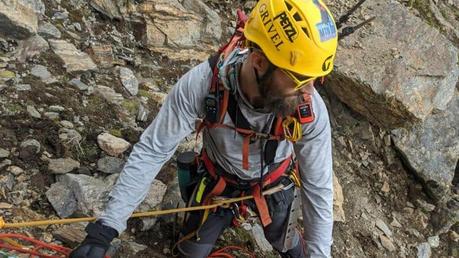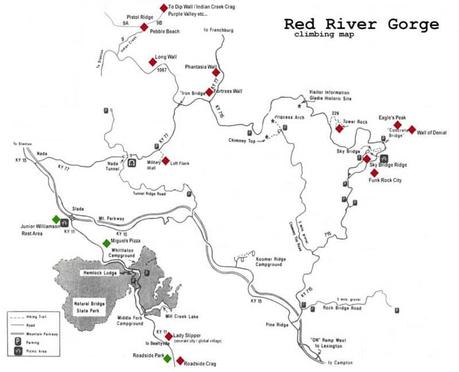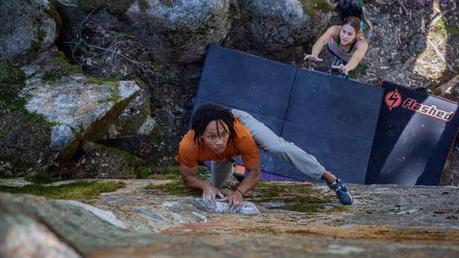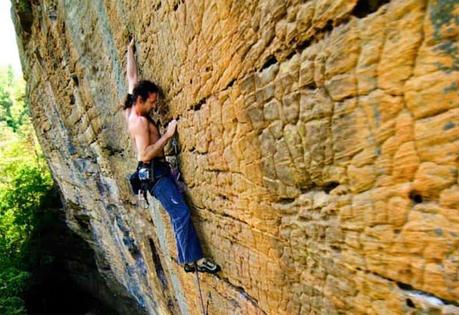Rock climbing is a great time that combines physical exertion with mental resilience. Few locations match the allure of the Red River Gorge Located in Kentucky’s Daniel Boone National Forest. This area is a paradise for climbers, especially beginners who are looking for an adventurous start to their climbing journey.
Introduction
Overview of Red River Gorge as a rock climbing destination
Red River Gorge, often simply referred to as “The Red”, is world-renowned for its sandstone cliffs, arches, and rock formations. These geological features provide countless climbing routes suitable for all skill levels, making it an ideal spot for new climbers to learn and hone their skills. The rock walls of The Red are weathered into a variety of shapes and sizes, offering a diverse range of climbing experiences within a relatively compact area. This, coupled with the breathtaking natural beauty of the surrounding forest, makes every climb at Red River Gorge a unique and unforgettable experience.
Benefits of rock climbing for beginners
Embarking on rock climbing as a beginner not only provides an exciting way to enjoy nature, but it also offers numerous physical and mental benefits. Physically, climbing is a full-body workout that improves strength, flexibility, coordination, and balance. Mentally, it promotes problem-solving skills, boosts confidence, reduces stress, and fosters a sense of achievement. For beginners, learning to climb at a location like Red River Gorge allows them to experience these benefits while enjoying stunning landscapes and being part of a supportive climbing community.
Safety and Equipment
Importance of safety in rock climbing

While rock climbing can be exhilarating, it’s crucial not to overlook the importance of safety. Climbing involves inherent risks, from minor injuries such as scrapes and bruises to more serious ones like fractures or falls. Therefore, understanding and adhering to safety guidelines are vital for a successful and enjoyable climbing experience. This includes proper use of equipment, knowledge of climbing techniques, awareness of personal limits, and constant vigilance of the environment.
Essential equipment for rock climbing
The basic gear required for rock climbing includes a climbing harness, a helmet, climbing shoes, carabiners, a belay device, and climbing ropes. A harness secures climbers to a rope, ensuring they don’t fall far if they lose their grip. The helmet shields against falling debris and protects the head in case of a fall. Climbing shoes improve traction on the rock surface, while carabiners and belay devices manage the rope during climbing and descending. Using high-quality, well-maintained equipment is key to maximizing safety during climbs.
Choosing the right climbing shoes and harness
Selecting the right climbing shoes and harness is paramount for comfort and safety. Your climbing shoes should fit snugly but not painfully, offering good sensitivity to the rock without causing discomfort. Rubber soles provide the necessary grip. As for the harness, it should sit above your hips and be tight enough that it won’t twist around. It should have a good range of adjustability to accommodate different clothing layers. Trying on several models and brands will help you find the best fit for your body shape and climbing style.
Basic Techniques for Beginners
Proper body positioning and footwork
Good climbing technique is rooted in effective body positioning and footwork. For body positioning, aim to keep your hips close to the wall and your center of gravity balanced. As for footwork, place your feet carefully and deliberately on the rock, using the edges of your shoes for precision. Try to distribute your weight evenly between your hands and feet, and remember that legs are stronger than arms – use them as much as possible for lifting your body upward.
Handholds and gripping techniques
Understanding the various types of handholds – edges, pockets, jugs, crimps, slopers, and others – and how to grip them effectively is key to maneuvering up a climb. A common beginner’s mistake is gripping the holds too tightly, which quickly leads to fatigue. Instead, aim for a firm but relaxed grip, using as little strength as necessary to maintain stability. Remember, climbing is more about finesse than brute force.
Basic climbing movements and transitions
Learning basic climbing movements, such as the mantel, smear, stem, flag, and dyno, will provide you with a toolkit to navigate different climbing situations. Practice these moves repeatedly until they become second nature. Transitioning smoothly between different positions and holds is equally important. This requires flexibility, balance, and an understanding of how to shift your weight efficiently. Mastering these skills will enable you to climb more fluidly and conserve energy.
Climbing Routes in Red River Gorge
Popular climbing routes for beginners
Red River Gorge offers a multitude of beginner-friendly climbing routes. Some popular choices include “Practice Wall” at the Phantasia area, known for its moderate climbs and excellent top-rope options, and “Great Arch” at the Sky Bridge area, featuring a massive arch with plenty of holds for beginners. “Bruise Brothers Wall” at the Muir Valley area is another excellent spot for novice climbers, with a high concentration of easy to moderate routes.

Difficulty ratings and route selection
In rock climbing, difficulty ratings provide an estimate of a route’s challenge level. In the United States, the Yosemite Decimal System (YDS) is commonly used, with ratings starting from 5.0 (easiest) to 5.15 (most difficult). As a beginner, look for routes in the 5.5 to 5.8 range. Once you’re comfortable with these, you can gradually progress to more challenging routes. Always be aware of your abilities and limitations, and don’t rush into climbing routes beyond your skill level.
My Favorite Red River Gorge Routes – Beginner Sport ClimbingExploring different types of climbing routes
The Red River Gorge offers various types of climbing routes, including sport climbing, traditional (trad) climbing, top-roping, and bouldering. As a beginner, you might start with top-roping, where the rope is already set up through an anchor at the top of the route. Sport climbing involves routes with pre-placed bolts and requires knowledge of lead climbing and belaying techniques. Trad climbing is a more advanced style that involves placing your own protective gear as you ascend. Bouldering involves climbing smaller rock formations without ropes using crash pads for protection. Exploring these different types of climbing routes allows beginners to gain a well-rounded understanding of the sport and discover their preferred style of climbing.
Climbing Etiquette and Rules
Respecting the environment and local regulations
As climbers, it’s our responsibility to respect the natural environment and minimize our impact on the fragile ecosystems we climb in. Red River Gorge is no exception. Always stay on designated trails and avoid trampling vegetation. Leave no trace by properly disposing of waste and packing out any trash. Familiarize yourself with any specific regulations or restrictions set by the local land management authorities to ensure you’re climbing within the permitted areas.

Sharing climbing spaces and communication with other climbers
Red River Gorge attracts climbers from all over the world, so it’s essential to practice good etiquette and be considerate of others sharing the climbing spaces. When arriving at a popular route, take turns with other climbers to avoid overcrowding and allow everyone a chance to climb. Communicate clearly with your climbing partners and other climbers to coordinate movements and ensure everyone’s safety. Remember, climbing is not only an individual sport but also a community where mutual respect and cooperation are key.
Being aware of potential hazards and risks
Rock climbing involves inherent risks, and Red River Gorge is no exception. Be aware of potential hazards such as loose rocks, unstable terrain, or unexpected weather changes. Always evaluate the condition of the rock and use caution when selecting and testing handholds and footholds. Stay vigilant for potential falling objects from climbers above and communicate any concerns with your climbing partners. By being aware of these risks and taking necessary precautions, you can minimize the chances of accidents and ensure a safer climbing experience.
Tips for a Successful Climbing Experience
Warm-up exercises and stretching routines
Before starting any climbing session, it’s crucial to warm up your muscles and prepare your body for the physical demands of climbing. Perform dynamic stretches that target the major muscle groups used in climbing, such as your arms, shoulders, core, and legs. Incorporate light cardio exercises like jogging or jumping jacks to get your blood flowing. Warming up not only reduces the risk of injury but also enhances your performance on the rock.
Building strength and endurance for climbing
To improve your climbing abilities, it’s essential to build strength and endurance specific to the sport. Incorporate exercises that target the muscles used in climbing, such as pull-ups, push-ups, finger strength exercises, and core workouts. Additionally, engage in activities like hiking, yoga, or cycling to improve overall fitness and endurance. Consistency is key, so aim for regular training sessions to gradually enhance your climbing skills.
Mental preparation and overcoming fear
Climbing can be mentally challenging, especially for beginners who may face fear and anxiety on the wall. Mental preparation is just as important as physical training. Develop strategies to manage fear and focus on positive self-talk to build confidence. Visualization techniques can also be helpful, where you imagine yourself successfully completing a climb before attempting it. Surround yourself with supportive climbers who can provide encouragement and guidance as you overcome your mental barriers.
FAQs
Is Red River Gorge worth visiting?
Yes, Red River Gorge is worth visiting. It offers stunning natural scenery, hiking trails, and outdoor activities.
What city is closest to the Red River Gorge?
Slade, Kentucky.
Can you swim in the Red River Gorge?
No, you cannot swim in the Red River Gorge. The Red River Gorge is a protected wilderness area in Kentucky and swimming is prohibited.
Does Red River Gorge cost money?
Red River Gorge does not cost money to visit.
Conclusion

Red River Gorge offers an incredible experience for beginners venturing into the world of rock climbing. With its stunning rock formations, diverse climbing routes, and supportive climbing community, it’s an ideal destination for those looking to embark on this exciting journey. Remember to prioritize safety, choose the right equipment, learn proper techniques, respect the environment and fellow climbers, and take care of your physical and mental well-being.
By following these guidelines and immersing yourself in the thrill of climbing, you’ll create memories and develop skills that will last a lifetime. Whether you’re looking to challenge yourself physically, conquer your fears, or simply enjoy the beauty of nature from a different perspective, rock climbing in Red River Gorge can provide all of that and more.
One of the great things about Red River Gorge is its accessibility for beginners. There are plenty of routes suited for those who are new to climbing, with varying levels of difficulty to choose from. This allows you to start at a level that you feel comfortable with and gradually progress as you gain more experience and confidence.

The rock formations in Red River Gorge are truly breathtaking. From towering cliffs to intricate crags, the area offers a diverse range of climbing options. You’ll have the opportunity to climb on sandstone, limestone, and other types of rock, each with its own unique characteristics and challenges.
But it’s not just the rock itself that makes Red River Gorge special. The climbing community in the area is incredibly supportive and welcoming. Whether you’re a complete beginner or an experienced climber, you’ll find people who are passionate about the sport and eager to share their knowledge and experiences. This creates a positive and encouraging atmosphere that can greatly enhance your climbing journey.
Of course, safety should always be a top priority when rock climbing. Make sure to invest in proper equipment, including a helmet, harness, and climbing shoes. Learn and practice the necessary techniques, such as tying knots and belaying, before attempting any climbs. And always climb with a partner who can assist you in case of an emergency.
Respecting the environment and fellow climbers is also crucial. Stick to designated trails, avoid disturbing wildlife, and follow any rules or regulations set by the park. Be considerate of other climbers by not hogging routes and being mindful of noise levels. Remember, we all share the same love for climbing, so let’s keep the climbing community strong and respectful.
Lastly, take care of your physical and mental well-being. Rock climbing can be physically demanding, so make sure to warm up properly, stay hydrated, and listen to your body. Don’t push yourself too hard and always prioritize safety over ego. Additionally, rock climbing can also be mentally challenging. Learn to manage fear and anxiety, trust your abilities, and embrace the thrill of pushing past your limits.
In conclusion, Red River Gorge offers an incredible experience for beginners venturing into the world of rock climbing. From its stunning rock formations to its supportive community, there’s no better place to embark on this exciting journey. By prioritizing safety, you respect the environment and fellow climbers.

